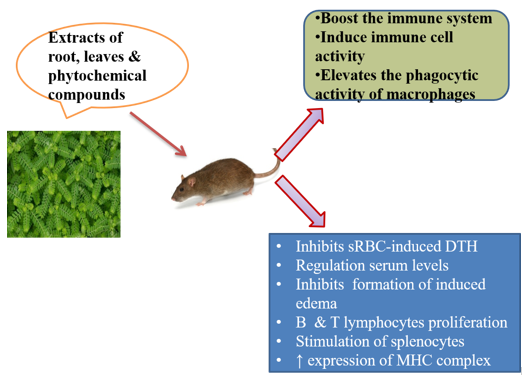Introduction
The human immune system is well organized comprising of many different immune cells like macrophages, neutrophils, T-lymphocytes, natural killer cells and various other specialized immune molecules like cytokines, antibodies and complement proteins that have evolved to mediate resistance against infections which is due to presence of active ingredients like bioactive phytochemicals which include lignans, flavonoids, terpenoids, alkaloids, polyphenols, coumarins, saponins, tannins and broad pharmacological actions.1 The methanol extract of P. niruri was reported to modulate both innate and adaptive immune responses. Among the compounds abundantly identified in the plant, catechin, quercetin, and astragalin have been reported for their ability to regulate the immune system.2, 3
Human studies
Repandusinic acid inhibited human immune deficiency virus by type-1 reverse transcriptase (HIV-1-RT) with an ID50 value of 0.05mM. It showed 10-fold more sensitivity towards HIV-1-RT compared with human DNA polymerase-a, which is an indication of good selectivity in inhibiting HIV replication without harming normal cells of the body when they were exposed to extract. In addition, 4.5 mM of this compound inhibited 50% of HIV-1 induced giant cell formation. Also, at 2.5 mM it inhibited HIV-1 specific p24 antigen production in Clone H9 cell system. The compound showed strong inhibitory activity against HIV-1 protease, with an IC50 value of 12.5 mM.4, 5
Table 1
Immunomodulatory effects of P. niruri
Invitro studies
Nworu and others found the effect of Aqueous extracts of P. niruri on spleen cells of female C57BL/6 mice (at a dose of 12.5-200 μg/ml for 18 h), there was increase in the expression of induced surface activation marker (CD69), B and T lymphocyte proliferation. The extract stimulated naive splenocyte by increasing the release of interferon gamma (IFN- γ) and interleukin-4 (IL-4) in a concentration dependent manner. Then various indices of activation and functions of murine bone marrow derived macrophages, such as phagocytosis, lysosomal enzyme activity and TNF-alpha release were significantly enhanced by pretreatment with P. niruri extract, which also modulated macrophage nitric oxide by release.6 They also studied the effect of Aqueous extracts of P. niruri on female C57BL/6 mice and transgenic OT-1 mice (at a dose of 25-100 μg/ml for 48 h), there was an increase in the expression of major histocompatibility complex-II and markers for dendritic cell maturation (CD40), activation (CD83) and co-stimulation (CD86).7 Putrid and coworkers found that the effect of Aqueous extracts of P. niruri on tuberculosis, patient there was an increase in nitric oxide, phagocytic activity and boosts the immune system in a dose dependent fashion, ultimately modulating the immune responses.8
Animal studies
Bonilla and oettgen found the effect of methanol extract of P. niruri on Swiss albino mice (at a dose of 200, 400 mg/kg) which helps in regulation of cellular immune responses by inhibiting sRBC induced DTH (Delayed-Type-Hypersensitivity) reaction. DTH is an important cell-mediated immune response and occupies the central role to protect the body against intracellular pathogens. This cellular response is primarily mediated by T helper type-1 cells which releases the cytokine IFN-γ. This cytokine causes the activation of macrophages and accounts for the symptoms of inflammation. Also, cytotoxic T cells and memory T cells are considered to be involved in DTH reaction9, 13 Animal studies by Muthulakshmi and others found the effect of Aqueous extracts of P. niruri on Oreochromis mossambicus (at a dose of 0.02 to 20 mg/kg body weight) stimulating effects on neutrophil activation and the antibody response and later it can be used either as a routine feed supplement to activate the immune system of farmed fishes or as an adjuvant to enhance the efficacy of vaccines.12 Eze and co-workers found the effect of methanol extract of P. niruri on Swiss albino mice (at a dose of 200, 400mg/kg) and found to regulate the serum levels of primary and secondary antibodies.10 Porto and others worked on spray-dried standardized extracts with varied concentrations of 100, 200, 800, 1600 mg/kg have found to inhibit carrageen induced edema and thioglycolate induced neutrophil migration in musculus Swiss male mice.11
Conclusion
Altogether, all of the studies depicted P. niruri’s clinical efficacy as an immunomodulator through the activation and augmentation of the cellular immune system. Specifically, P. niruri activates neutrophils, macrophages or monocytes, and T and B lymphocytes. Activated phagocytic process by the neutrophils suggests an acceleration of the active eradication process, particularly of the extracellular pathogens, such as invading viruses, microbes, or fungi and their removal from our bodies. Further, the modulation of cytokine secretion by P. niruri treatment, as observed in various clinical studies, such as stimulation to IFN-γ, TNF-α, IL-4, IL-6 strongly indicates that P. niruri influences our body’s defense reaction involving cellular immune system against foreign pathogens.

